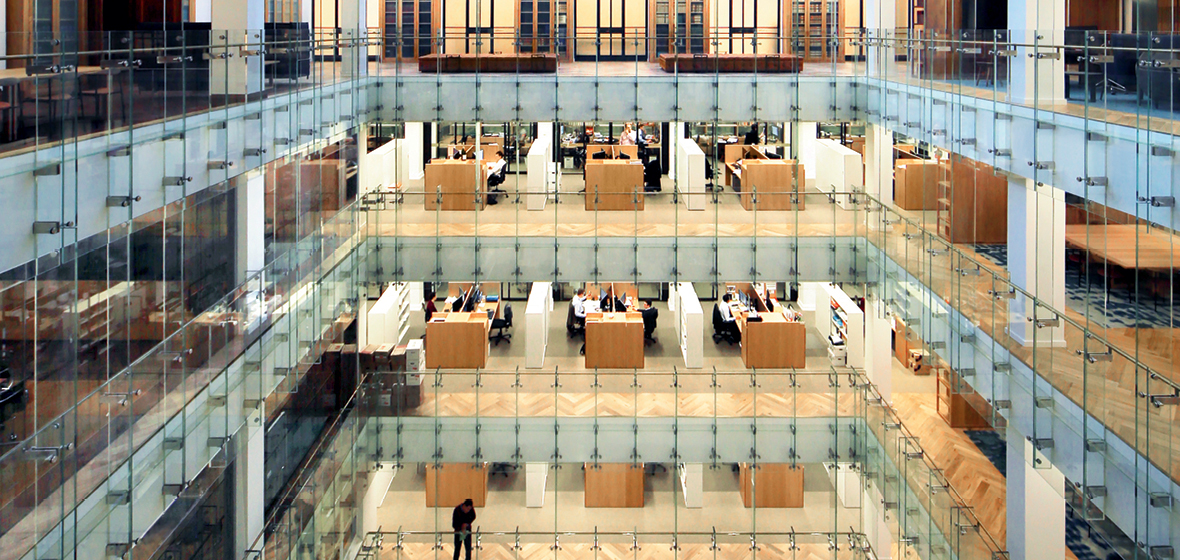I thought, if I’m going to be fair dinkum about moving the office to an open-plan workspace and collaborating between teams, I need to lead by example.
Lawyers of the future will be office-less nomads who can work from anywhere in the world with an internet connection.
Once upon a time, lawyers inherited offices with big leather chairs and harbour views as a sign of seniority. Only their clerk minions would slum it in the sprawl of open-plan cubicles.
But that all changed for Gilbert + Tobin managing partner Danny Gilbert when his firm moved to its new open-plan offices in Sydney last year. The firm’s ultramodern digs in Barangaroo Tower Two did away with individual offices, with Gilbert swapping his airy corner office in the firm’s former site on Park Street for a desk among his junior employees.
“I don’t like asking people to do things I don’t like to do,” Gilbert says. “I thought, if I’m going to be fair dinkum about moving the office to an open-plan workspace and collaborating between teams, I need to lead by example.”
Gilbert initially took a desk next to a young graduate, who was forced to overcome any initial unease of sitting next to the managing partner responsible for half of the firm’s name. He now rotates his position every two months to get to know people from different teams.
Gilbert says some lawyers – particularly paper-heavy litigation teams – took a while to adapt to sharing storage space. However, most see the benefit of the new layout for encouraging collaboration.
“Most partners really like it and see the benefit of having more open communication between senior and junior lawyers and different teams,” Gilbert says. “Traditional offices are a fortress against open communication.”

Open-plan trends
A 2016 report into the future of law firm workspaces by Melbourne architecture firm Bates Smart found that in 2007, 75 per cent of legal staff worked in separate offices rather than in open-plan environments. By 2016, that number had dropped to just 35 per cent. The report predicted that by 2020, only 10 per cent of legal staff would still work in individual offices.
The report also noted that since 2007 the average area per person in law firms had dropped from 24 square metres to 16 square metres, and forecast this number would fall to 10 square metres by 2020. According to George Beaton of legal consulting firm Beaton Research + Consulting, downsizing is one of the simplest ways for a law firm to save money. As a cost, rent is second only to salaries in most firms.
 DANNY GILBERT, managing partner, Gilbert + TOBIN
DANNY GILBERT, managing partner, Gilbert + TOBIN
By shrinking their physical footprint, Beaton says firms can make substantial savings.
“Law firms with individual offices are running at 20 to 25 square metres per person,” Beaton says. “By moving to an open-plan workspace they can halve that, and halve the rental part of their costs.”
Gilbert + Tobin leased about 9,300 square metres in its former offices on Park Street. By moving to Barangaroo, the firm reduced this footprint to about 8,300 square metres – a space saving of more than 10 per cent.
“On a financial basis, open-plan is critical to reducing the high fixed cost of rental space,” Beaton says. “The cultural reason is that open space invites productivity and collaboration.”
Proponents of open-plan offices say they also foster collaboration and a collegial atmosphere, however, it appears the jury is still out on how open-plan layouts affect employees’ productivity. A 2016 study by Oxford Economics found that open-plan offices “come with serious drawbacks like noise and distraction”, which stalls productivity more than most executives realise.
“For every study you find that says open-plan improves productivity, you’ll find another one that says it doesn’t,” Beaton says. “In my experience, it does increase productivity. I personally have never worked in a closed office and I can’t imagine working in a closed office.”
At Herbert Smith Freehills in Sydney, partners, special counsel and senior associates have private offices while lawyers and paralegals work in open-plan desk space, clustered in practice teams nearest the office of the partner managing their team. Tim Coorey, a solicitor in Freehills’ corporate mergers and acquisitions team, says this hybrid model fosters team collaboration and, in his words, “great banter”.
Hot-desking
Coorey says he would feel uncomfortable if Freehills were to introduce “hot-desking” – where workers have no assigned desk but are encouraged to move to different workstations every day. Instead of storing their stationery and snacks in desk drawers, employees are often assigned lockers. Any belongings they leave behind at workstations are thrown out by cleaners each night.
“I wouldn’t like that,” Coorey says. “I like to leave all my things where they are – not pack up and clean out every day. I like to keep my cereal, all my different types of tea, ties, toiletries and stationery in my desk drawers within reach.”
Coorey may end up having to relocate his tea collection if law firms follow the hot-desking trend of other big corporate companies. In Australia, large consulting firms and banks such as KPMG, Macquarie Group and Commonwealth Bank of Australia have introduced hot-desking. A 2017 survey by commercial real estate agents CBRE found that two-thirds of multinational companies plan to adopt similar shared-desk strategies by 2020.
Despite the trend, lawyers in the “big six” Australian firms remain tethered to assigned workstations. Studio Director at Bates Smart, Kellie Payne says this is because hot-desking is not as practical for large law firms.
“The benefits of unassigned desking are greatest for teams that spend large amounts of time out of the office or in meetings,” Payne says. “This doesn’t align with traditional legal work where lawyers spend long hours at their desks and collaborate with team members.”
What I see coming over the horizon is shared back offices, outsourced back offices housed in low-cost international jurisdictions such as Kuala Lumpur. The cost savings are amazing.
GEORGE BEATON,
Beaton Research + Consulting
Into the cloud
There is a significant practical issue for firms that adopt open-plan or shared-desk strategies: where do all the files go? Lawyers are notorious for being paper intensive and physically marking up documents, so it’s often a tremendous task to let go of that paper.
When MinterEllison moved to its new offices at Governor Macquarie Tower last May, it moved about 70 per cent of its physical files into digital storage over a nine-month effort called Project Declutter. This represented about 5,200 metres in space savings for the firm. The firm also disposed of most of its library and moved the books to an online format for employees to access. Partner Andrew Cunningham joked that just a few physical books remained “to show young graduates what books look like”.
Law firms increasingly are moving document storage systems into the “cloud” so lawyers can access files from anywhere in the world using the internet. Beaton says smaller “disruptor” firms tend to be more progressive than big firms in this space, and are well ahead when it comes to going paperless.
“This is a huge trend for law firms,” Beaton says. “The future lies in the cloud. Cloud and mobile are enabling lawyers to work from anywhere at any time and that trend is accelerating all over the world.”
Mark Gardiner is the CEO and founder of Teddington Legal, a firm of 15 lawyers who work from home or at open-plan desks in a warehouse space in Sydney. Gardiner explains why Teddington has no physical files and stores all its files in a cloud-based system.
“The advantage is lawyers can work from wherever they feel comfortable,” Gardiner says. “They can work from home, they can use another office or they can have a physical presence in anywhere they want to have an office.
“In this day and age, I believe you don’t have to physically see a client to provide an effective legal service. We’re very big on video conferencing and on regular and frequent telephone calls with clients.”

What’s next?
Beaton believes the trend towards 24-hour legal work will have more dramatic impacts on firms than the widespread adoption of “casual Friday” attire.
“What I see coming over the horizon is shared back offices, outsourced back offices housed in low-cost international jurisdictions such as Kuala Lumpur,” Beaton says. “Lawyers will be able to send routine processing work, accounting work, IT tasks, marketing and practice management systems overseas, at a fraction of the labour cost you would pay a lawyer to do it in Australia. This is already happening in some firms and the cost savings are massive.”
The downside of dipping into the international labour market is that firms are less likely to employ graduate lawyers or clerks to do traditional grunt work such as discovery. Beaton says firms may end up offering fewer clerk or graduate positions. He predicts that young lawyers of the future may begin sharing shifts to service clients around the clock.
“I know international firms overseas that have already introduced shift work,” Beaton says. “They roster their paralegals and junior lawyers into two shifts each day – from 7am to 3pm and the second from 3pm to 10pm. Instead of one lawyer working a 16-hour day, lawyers work a standard eight hours.
Tim Coorey, who sometimes works long days when a deal is going down, is sceptical about shift work. “It’s impractical,” he says. “There would have to be handovers every day, which would take time, and I don’t know if you’d be able to gain the same in-depth knowledge of your client’s matter.”
Coorey admits lawyers would probably enjoy physical and mental health benefits if their days were shorter. Now that they’re all working “out of office” anyway, perhaps shift-enforced downtime is the only way to pry lawyers of the future away from their open-plan desks.




